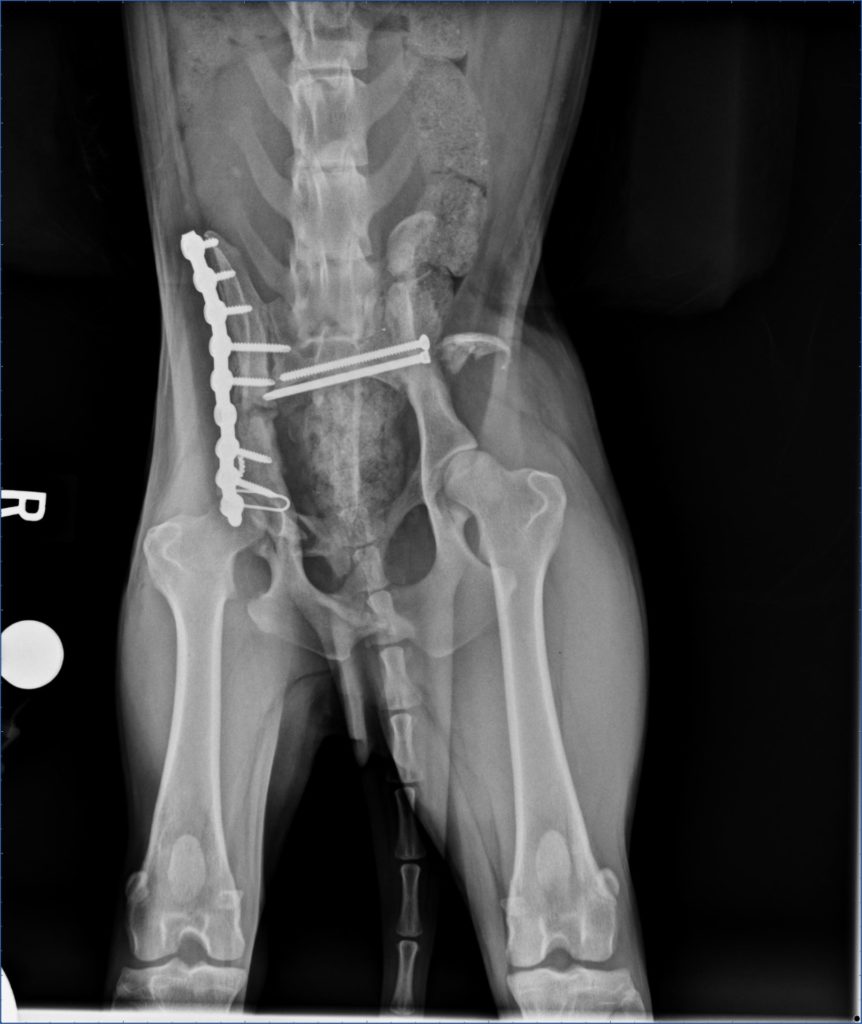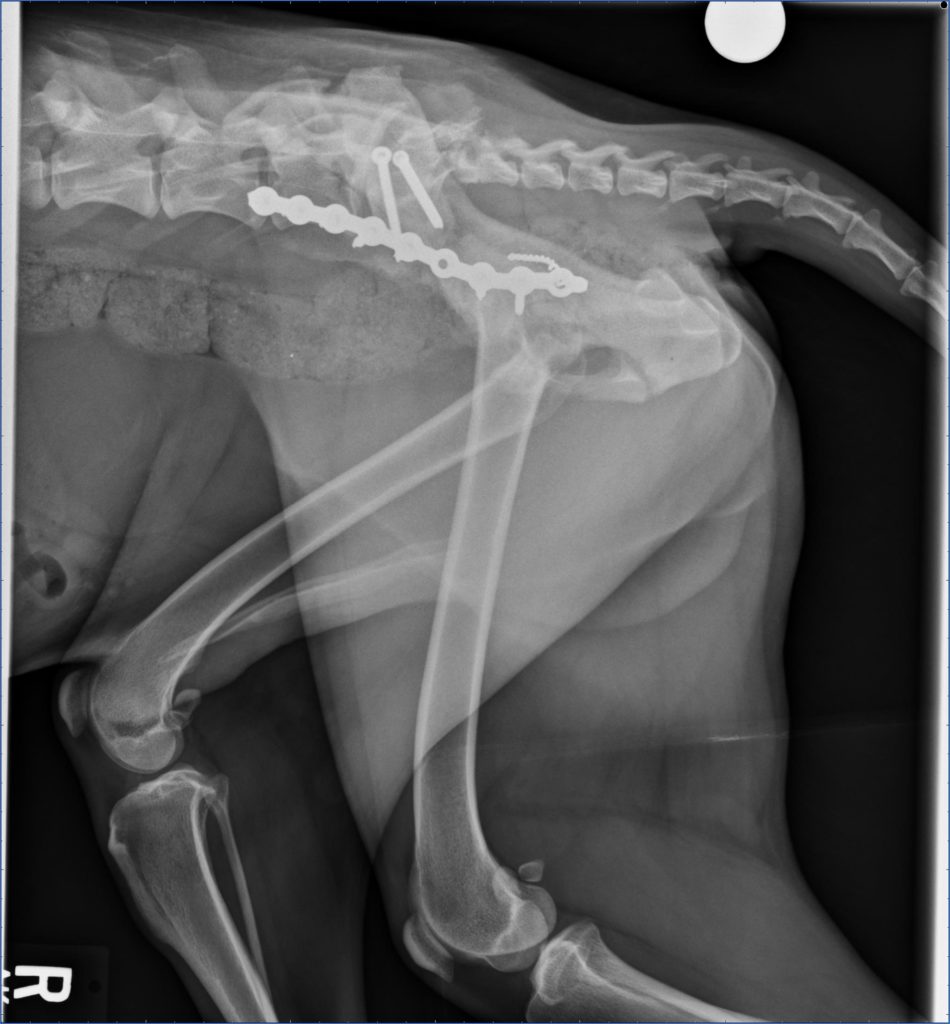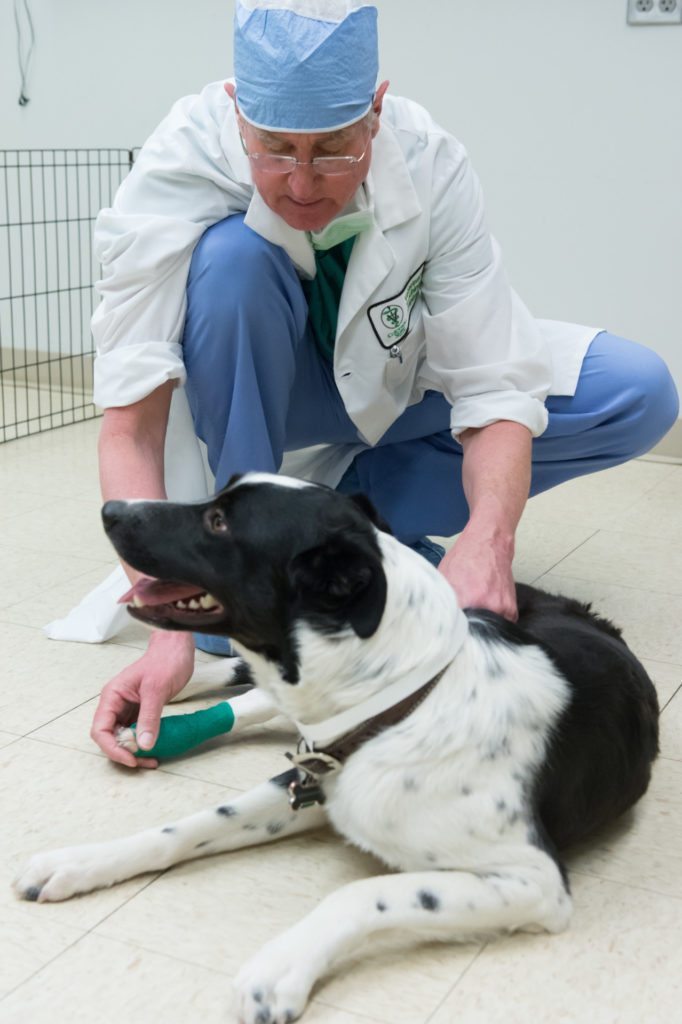As Boone the Border collie recovers after being hit by a truck, his CSU veterinarians use X-rays, lab results and neurological tests to determine how he is healing. But for his owners, Katherine and Josh Hawkins, Boone’s tail rivals any diagnostic tool.
Each month, Boone can wag just a little more of his white-tipped tail. It’s a sign that he is regaining nerve function after his pelvis was pulverized and his partially paralyzed tail didn’t move at all.

“We don’t have children, so our dogs are our kids,” Josh says, explaining his close attention to Boone’s recovery. “We could see the fire in his eyes, and we believed in him.”
On Oct. 7, 2015, while the Hawkinses were at work, the 1½-year-old Boone got out of their yard in Hudson, Colo., and was hit by a truck at high speed, just as a neighbor was trying to coax him back to safety.
He suffered a fractured facial bone, a broken pelvis, a traumatic brain injury, bruising on his heart and lungs, dislocated joints, and a heart arrhythmia. His local veterinarian, Dr. Talor Lingus, determined that he needed intensive emergency care, and referred him immediately to Colorado State University, her alma mater. Katherine held Boone as they raced the 60 miles from their home in eastern Colorado to the James L. Voss Veterinary Teaching Hospital, where specialists could treat his multiple wounds.
Boone spent the next 10 days in the critical care unit at the Veterinary Teaching Hospital, where a team led by Dr. Eric Monnet, a professor of small animal surgery, stitched up his soft-tissue wounds, and orthopedic surgeons performed two day-long surgeries on his fractured bones and dislocated joints.
“His pelvis was dislocated from the rest of his skeleton. He was in pretty bad shape, but we knew would be able to fix his pelvis,” says Dr. Daniel Nucci, a surgical resident who performed the orthopedic surgeries along with faculty member Dr. Nic Lambrechts. They implanted pins in several places to hold his bones together.
Quality-of-life questions

Doctors knew they could mend Boone’s broken bones, but they weren’t sure if he would ever regain bladder and bowel control. In the early hours of Boone’s treatment, his owners faced difficult decisions about how far to go in saving the dog’s life.
“We had a lot of heart-to-heart talks about, ‘Are we doing the right thing?’ We didn’t want him to have poor quality of life after his recovery,” Katherine says. “Dr. Nucci is excellent, and he worked closely with all the other doctors on the case. Everyone was very straightforward but also very positive, and we needed that to get through it ourselves.”
While Josh and Katherine talked and prayed, a team of doctors, nurses and students worked across veterinary disciplines to assess and treat Boone’s injuries. Anesthesia technician Misty Moranville is one of those key team members who rarely meets with clients. She interacts intimately with animal patients, often when they are in the worst shape, and stays with them through surgery, monitoring vital signs and ensuring they are pain-free. The job requires a stoic professionalism that protects the caregiver and their animal patients.
“Boone is such a sweet boy. He would just lie there and give you kisses. He would have wagged his tail if he could have,” Moranville says. “You have to take a step back and compartmentalize, but there are certain patients that pull on your heart strings.”
She never met Katherine and Josh, but the friendly Border collie touched her heart.
“We often don’t get that closure, but I make a point to go talk to the doctors and see how the patients did,” Moranville says. “I just happened to be near critical care when they took Boone to walk for the first time. I cried. I lost it. For him to be able to move that right leg was overwhelmingly emotional for me.”
Those were Boone’s first steps toward recovery.
Collaboration across the hospital

“This was one of those collaborative cases where every step you take, you’re talking to everyone on the case,” says Sasha Foster, a physical therapist who switched from working with humans to animal patients. She and technician Laura Southworth helped Boone get back on his feet, literally. And like every patient that comes to the hospital, Boone gave students a chance to learn.
During an early physical therapy session, Foster gently touches Boone along his spine. “If you tell us where it hurts, Boone, we’ll make it feel better. He still has pain on his sacrum,” says Foster as she shows a student how to feel for discomfort. “Angela, isn’t that cool? A nice patellar reflex. Boone, you’re a good teacher.”
Angela Abbott, a fourth-year veterinary student, sets up poles between orange traffic cones, just a few inches off the floor. She leads Boone to step over a pole while Foster watches, assessing how he puts weight on his back feet. He’s favoring the right leg and at times his toes fold under, rather than extending normally.
Next, laser therapy and electrical stimulation relieve pain and help Boone’s damaged tissue heal. “This is the cool part,” says Foster, as she places dark glasses over Boone’s eyes to protect them from the laser. “After five to seven minutes of the TENS unit, the dogs just melt. It’s the exact same technology that’s used on humans.”
At home, Katherine, an architectural designer, worked half-days at home for four months while Boone recovered. Josh built a fenced-in dog run that connects their yard to the barn so that Boone can safely work out his Border-collie energy.
“One of the things the doctors had warned us about was bladder and bowel control, but that has come back. He’s had no accidents in the house at all. That’s huge – it just shows how far he’s come,” Katherine says.
Six months after facing death, Boone is back at the ranch, herding barn cats, playing fetch and wrestling with other dogs.
“He’s a good example of a miracle case,” says Lingus, Boone’s primary care veterinarian. “And also,” she adds, “owners who were willing to put in the time to help him have a full recovery.”
Boone wags his tail in agreement.
Media Assets
Photos
Click on photos in story for full-size image
Video